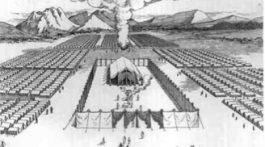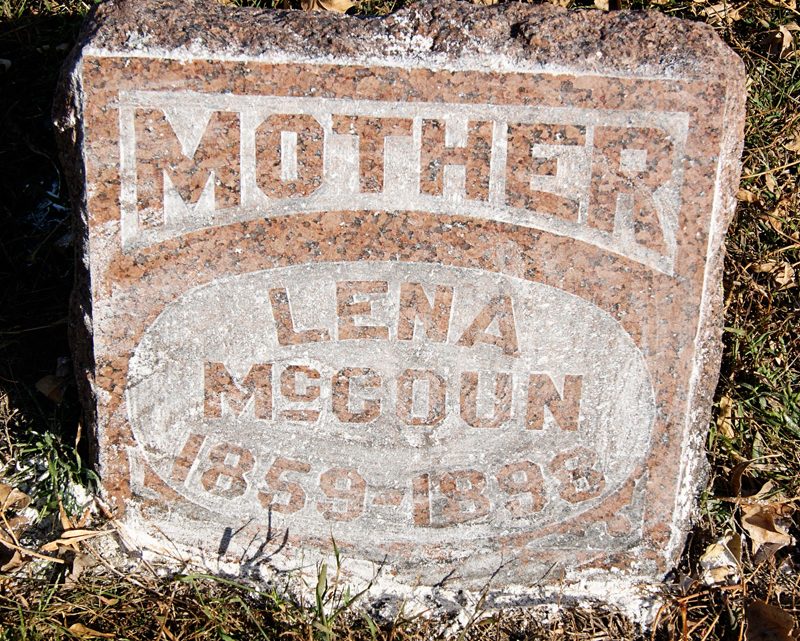Part 1 of this story examined the deeply held gender bias in the journalism reporting on the deaths of Arthur L. Snook and his wife, Ms. Sawyer. In a surreal turn of events, in leaving her first husband, Ms. Sawyer may have been trying to escape the very scenario that took her life.
A Life of Misery and Wretchedness
Leonard T. McCoun’s son, John Roy (or Robert) McCoun, like his father was also an attorney, a justice of the peace, and in fact was the first county attorney for Graham County, Kansas, as well as sometime mayor of New Market, Iowa. Unfortunately, any misery—as accused by her father-in-law —Ms. Sawyer gave John is another hole in the story. They married in Bedford on February 11, 1875, and soon moved to Kansas, where Myrtle was born in Osborn on October 5, 1877. There are hints that John also dealt in real estate in Kansas, but no indication of what led to their divorce around 1887. However, there is no doubt that he was a source of misery and wretchedness for another woman, Maria Magdalena.
Although known as Lena most of her life, she was given the name Maria Magdalena at birth in 1859. Who her parents were and whether she was born in Germany or Illinois, remain unknown. Holes in the story.
Lena had married Henry J. Hornecker on February 5, 1882, in Adams County, Illinois. After the birth of their daughter, Ella Augusta (1882-1957), in 1882, the couple moved to Kansas where they tried farming for a while, before Henry bought a barber shop. In Kansas, a son, Raney Henry (1885-1956), joined the family on August 18, 1885. In June 1888, Henry became ill with tonsillitis, a potentially dangerous illness in a time before antibiotics; however, an account published in 1898 would claim he died under suspicious circumstances on June 16, 1888, in Millbrook, Kansas, leaving a 27-year-old widow with two young children. Although they can be imagined, Lena’s reasons for remarrying almost immediately are unknown. More holes in the story.
John and Lena first married sometime around 1888. It was never a happy marriage. Subsequent events indicate that John’s alcoholism and gambling was the center of their marital discord, but disagreements over faith and child custody were also factors. A daughter, known as Goldie S. (her birth name may have been Sall Ann; 1890-1969), was born to them in 1890, and the following year a son, Ernest Jacob (known as a Jakie or Jake; 1891-1975). According to newspaper accounts, Lena and John married and divorced at least three times. What was likely, their second marriage on June 1, 1892, is the only marital/divorce event for which a vital record is easily locatable.
Joining the Adventist Church
Lena McCoun joined the Adventist Church around 1893 as the results of tent meetings held by Josiah Sidney Hart and J. O. Beard. She was perhaps one of the five converts Hart reported in the October 9, 1893, issue of the Signs of the Times. By all accounts she was devout in her faith. “She [was] quite firm in the truth. . .and faithful in attending Sabbath school and meetings, much of the time at considerable sacrifice.” That latter phrase was a diplomatic way of saying her husband did not approve. On January 1, 1898, she and three of her children participated in a quarterly communion service during which she “bore a very decided testimony as to the comfort of the Christian’s hope.” (The Worker’s Bulletin)
The McCouns divorced for the final time in December 1897, but John was not content to leave Lena alone. Nursing grievances more imagined than real, he told an acquaintance on Friday evening, January 7, 1898, that he intended to kill Lena. This man unsuccessfully tried to dissuade John. Left to his own devices, John worked his way toward Lena’s home. As he walked, he met C. M. Roberts, whom he asked to go with him. One can only hope that Roberts thought he could stop John or did not think John would follow through with his threat.
Lena had just finished studying the Sabbath School lesson with her children in preparation for services the next day when John knocked on the door. Roberts’ presence may have made Lena more comfortable with opening the door to John. Upon entering the house John accused her of planning to move away and take the children with her. He demanded that she leave the youngest child with him. When she neither denied nor confirmed his accusation, he grew further enraged, pulled a gun and shot her multiple times. Roberts, ineffectual, at stopping John, ran for help. It was too late.
According to Lena’s daughter Ella, who was present, John attempted to kill himself at this point, but failed. He ran from the house and went into hiding, setting off a manhunt. Saturday morning, January 8, he was found in a haystack, having finally succeeded in mortally wounding himself. Still breathing when discovered, he died several hours later.
Unlike Arthur Snook for whom there was much sympathy, the press seemed to take great pleasure in reviling John McCoun. Even his father seems to have finally admitted that John was suffering from mental illness.
The Children
And what of the five children, the survivors of this horrific story? In the aftermath, it is difficult to determine what happened to them immediately. There are so many holes in this story. Understandably, none of them remained in Iowa, moving west and settling in locations scattered between Kansas and Washington. Myrtle and Ella were nearly adults and soon married. Raney lived with Ella and her husband for a time. The youngest son, Jake, appears to have stayed close to Myrtle. These four children maintained stable familial relationships, but there is no evidence they stayed in the Adventist Church.
Out of the five children, Goldie (1890-1969) was both the only one of the children to retain a connection to the Adventist church, but also the one who married three times, two of the marriages ending in divorce. Giving birth to six children, she became a nurse, as did her daughter Frances Fern (1913-2008), who studied at both Campion Academy and Boulder Sanitarium. When Goldie died on January 3, 1969, in Vancouver, Washington, she was remembered for her work as public relations secretary in her local Adventist church.
Retrospective
The largest hole in Lena’s story is the reason she would ever agree to one reconciliation, much less two, after living with the trauma of John’s dysfunction. Without her account, we can only speculate based on patterns of co-dependency, social constraints, and religious belief. Perhaps she feared being unable to support her children, or perhaps she really believed John when he told her he had changed. Perhaps he made coersive threats. Perhaps, even, her new faith gave her hope that God would change him. But, one also wonders what role fellow Christians played in convincing her that she should try to keep her marriage together. Did they understand the danger she was in? The trauma she faced? Based on John’s accusation the night she died, Lena may very well have been trying to relocate, to find a place of peace and safety away from her ex-husband. At least one newspaper reporter indicated that John’s violent attack was not unexpected.
As with Ms. Sawyer’s story in part 1, we will never know all the details of Lena’s story either. But these stories should make us stop and think before we criticize someone who is separated or divorced, before we preach faithfulness to marriage vows at all costs. What holes in their stories are we missing? The fact is, there is more than one way to be unfaithful, and if a spouse has proven to be untrustworthy and dangerous, divorce is necessary. Divorce is also traumatic and disruptive. It carries a long tail of consequences and grief for both partners, and their children. One that may require professional intervention, legal measures, and physical barriers, but also privacy. We don’t need to know the whole of person’s story before extending compassion.








